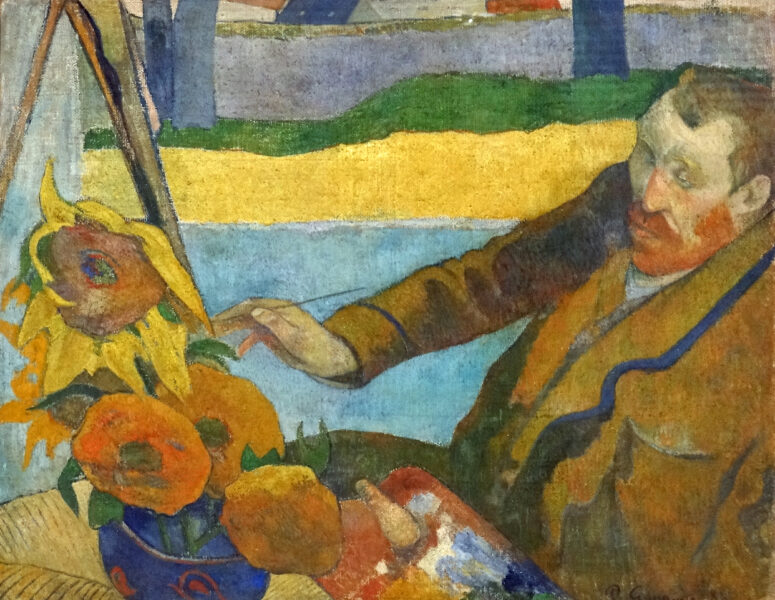
Just Stop Oil has been making themselves known on multiple accounts: whether that be halting traffic or vandalising buildings (such as car show rooms or even university buildings), these climate activists have been reaching many headlines – which is their goal in order to stir up much needed conversations around the climate crisis. But these protests can sometimes target industries that have little to no direct correlation with these political and ecological issues. The arts industry is becoming increasingly, as newspapers call it, ‘under attack’ from climate protesters associated with Just Stop Oil.
October 14th 2022 saw two youth activists, Phoebe Plummer (21) and Anna Holland (20) take action at the National Gallery in London. As part of their political display against the continued use of fossil fuels and the lack of renewable energy investments from the government, the duo threw tomato soup over Vincent van Gogh’s Sunflowers painting from 1889. They then proceeded to smear superglue across their palms and weld themselves to the wall beside it. During their protest, they asked onlookers, and of course the government, whether they value art or life more. This action went viral. Unsurprisingly, museum goers, who adore paintings such as the one vandalised by the protesters, reacted negatively to this political statement. Onlookers were shocked, many calling for security.
But perhaps the outrage sparked by art enthusiasts, and the public in general, is what is needed to initiate change. By targeting such a well-known and beloved masterpiece, it caused an eruption of emotions, which lured in media coverage easily. But this plays to Just Stop Oil’s advantage, as these demonstrations therefore encourage conversations around fossil fuels and the climate emergency that wouldn’t have otherwise occurred. Many reports focus more heavily on the costs associated with the vandalism and how damages are a serious cause for concern. The protesters, however, were criticising just that – we can’t ignore the priceless value of our planet’s health, which is ultimately being neglected as we continue to form a reliance on fossil fuels in our everyday lives. The protest is more about a political statement enveloped in symbolism. These ‘attacks’ are also ephemeral, and in this instance, it only took six hours for the painting to be cleared of tomato soup and a lick of paint to be applied to the walls where the girls superglued their hands to it. The artwork itself wasn’t directly ‘attacked’ on either, rather the frame and the protective glass took the impact.
It is, however, important to recognise that protests targeting the arts industry can also unveil some irritation amongst the public, as it is viewed as a useless approach that isn’t well thought out: asking for change, when the art industry doesn’t directly have a negative effect on the planet. The protesters view art in a different way – it provides a platform for discussions to be ignited. Due to the popularity of art within culture, it gains huge attention when it surfaces on the news, which means the climate activists ‘hijack’ the attention from art pieces and use it to redirect a conversation towards the climate crisis. Museums are often seen as a place for preservation, but in 2019, the International Council of Museums claimed that it is also a space for critical dialogue about the past and the future. In this way, museums are spaces to reflect the past and its collections, but also spaces to think about how we can take this and apply it to the future.
The climate activists ‘hijack’ the attention from art pieces and use it to redirect a conversation towards the climate crisis.
During a court appearance, Holland sported a sunflower T-shirt, and both girls claimed van Gogh would have supported using art in an attempt to create positive change. Plummer recounted that van Gogh said: ‘what would life be if we had no courage to attempt anything’. By choosing to throw tomato soup on Sunflowers, it made it appear as if the flowers were melting under the sun. There was an artistic and cunning approach to their actions.
The symbolic outlook presented by Just Stop Oil visually displayed their opinions. Climate change and its associated consequences are sometimes hard to comprehend, so it is easy to dismiss. Art has the power to make the invisible visible. Not only do these protests make the climate situation easier to digest, but it also encourages onlookers to question what actions are being taken at a government level to combat this crisis, and perhaps question what policies need to be called into action to make this happen.
Art has the power to make the invisible visible.
Protesters often come across as extremely passionate and extreme in their emotions, but this is often due to feelings being grounded in suffering and loss, such as the climate induced wildfires in Canada that have burnt millions of acres of land. During uncertain times and political instability, it is often easy to overlook the role art can play in addressing these issues. It is important to notice that art lays out a global stage on which political issues can be made more accessible to the public; engagement and empowerment of the public is paramount. Art can connect millions of people and this allegiance is necessary in the battle against the climate emergency. Art always has a place within politics and politics has a place within art, making the two inseparable. While it may be uncomfortable to see challenges to the norm, that is what will be necessary to create meaningful change for planetary health.


